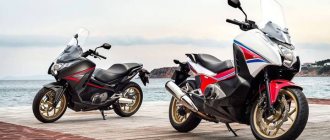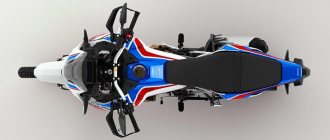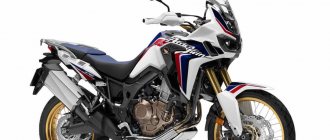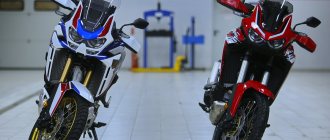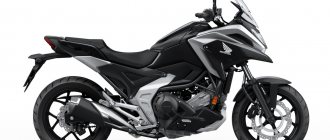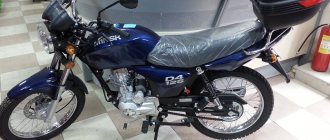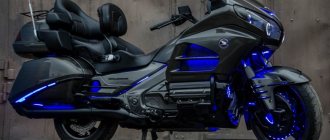| Honda CMX1100 Rebel (2021+) |
Cruiser model Honda CMX1100 Rebel
was officially introduced to the Honda motorcycle lineup on December 18, 2021 (model year 2021) as the flagship version in the CMX series.
The model is aimed at all major markets - Europe, North America, Japan, Australia. In the North American market, the model is sold under the name Honda Rebel 1100
.
The Honda CMX1100 Rebel was based on the engine from the adventure Honda CRF1100L Africa Twin, which was retuned and derated, producing 87 hp. power and 98 Nm of torque, which was fully available already at 4750 rpm. Along with the engine, the motorcycle also received two transmissions to choose from - a 6-speed manual or robotic with two clutches DCT (Dual Clutch Transmission). The DCT version of the Rebel 1100 is 10kg heavier and has a 20mm smaller overall width.
The use of the latest electronic systems has become equally important. Thus, the Honda CMX1100 Rebel model as standard has ABS, a 3-level HSTC (Honda Selectable Torque Control) traction control system, 4 Riding Modes, a Wheelie Control system and LED optics.
Unlike the younger version of the CMX line, the new Rebel 1100 is equipped with a more powerful suspension front and rear (43 mm front fork and rear shock absorbers with remote reservoirs), as well as a braking system - 1 330 mm front disc with a 4-piston radial caliper.
The price of a new motorcycle in Japan starts from 1,000,000 yen (~714,000 rubles) for the regular version with a manual transmission and from 1,100,000 yen (~785,000 rubles) for the version of the Honda Rebel 1100 with a DCT gearbox.
Honda CMX1100 Rebel: electronic equipment
- ABS
- Electronic throttle (Ride-by-Wire system)
- 4 Riding Modes
- HSTC (Honda Selectable Torque Control) (3 levels)
- Wheelie Control
- DCT (Dual Clutch Transmission) or 6-speed manual transmission
- Full LED optics
Honda CMX model series:
- Honda CMX250 Rebel
- Honda CMX300 Rebel
- Honda CMX500 Rebel
Specifications
Technical characteristics of Honda CMX1100 Rebel:
| Model | Honda CMX1100 Rebel |
| Motorcycle type | cruiser |
| Year of issue | 2021+ |
| Frame | Steel |
| engine's type | 2-cylinder, 4-stroke, in-line (22.5° tilt) |
| Working volume | 1084 cm³ |
| Bore/Stroke | 92.0 x 81.5 mm |
| Compression ratio | 10.1:1 |
| Cooling | liquid |
| Number of valves per cylinder | SOHC, 4 valves per cylinder (with hydraulic lash adjusters) |
| Fuel supply system | injector, PGM-Fi |
| Ignition type | transistor |
| Maximum power | 87 hp (64 kW) at 7000 rpm |
| Maximum torque | 98 Nm (10.0 kg*m) at 4750 rpm |
| Clutch | Multi-disc in oil bath, cable drive 2 multi-disc packs in oil bath (version with DCT automatic transmission) |
| Transmission | 6-speed 6-speed automatic - versions with DCT (dual-clutch transmission) |
| type of drive | chain |
| Front tire size | 130/70B18 M/C |
| Rear tire size | 180/65B16 M/C |
| Front brakes | 1 disc, 330 mm, 4-piston radial caliper (ABS) |
| Rear brakes | 1 disc, 256 mm, 2-piston caliper (ABS) |
| Front suspension | 43mm telescopic fork (preload adjustable), 122mm travel |
| Rear suspension | Pendulum with two shock absorbers (preload adjustment), stroke - 94 mm |
| Motorcycle length | 2240 mm |
| Motorcycle width | 850 mm 830 mm - Rebel 1100 (DCT) |
| Motorcycle height | 1115 mm |
| Wheelbase | 1520 mm |
| Seat height | 700 mm |
| Minimum ground clearance (clearance) | 120 mm |
| Acceleration 0-100 km/h (0-60 mph) | 4.16 sec[1] |
| Maximum speed | 164 km/h[2] |
| Gas tank capacity | 13.6 l (including reserve - 4.0 l) |
| Motorcycle weight (curb) | 223 kg 233 kg - Rebel 1100 (DCT) |
Honda CMX1100 Rebel test: “Honda, what are you doing...”
I've always had Hondas. The very first motorcycle, the very second, my husband’s motorcycle, even the car was Honda - yes, obviously, I have weakness, love and devotion to this company, although the lack of normal human, that is, like the VTX 1800, cruisers is frustrating. (Actually, not anymore, because I’m no longer a fan of this kind of devices, but for the sake of appearance, you have to be indignant.)
Natalya Umnova
For the sake of appearance, I’ll be indignant at the new Honda Rebel 1100. How could it be otherwise?! Does it look like a cruiser? Cruiser. Well, it almost looks like a bobber. The engine capacity is decent - 1100 cubic meters - yes... And then you begin to suspect something: Honda doesn’t have a V-twin of such a volume now. Then what is it? In-line “deuce” from “Africa”! Sob sob! Goodbye, beautiful sound, goodbye, dreams of a new classic heavy cruiser, goodbye to youth... (Do you think this is too much? Oh well!) Of course, Honda is not the first to interfere with the canonical structure of a healthy person's cruiser, but all sorts of Italians can get rid of it, and not to the one who plays on the same field with his Harley-Davidson comrades. Although... Rebel still has to live up to it.
Okay, what else do we have here. Center steps. Oh God! I don't know anyone who would be comfortable with them. But - lo and behold! - The Rebel has them positioned a little differently than other bikes I've tested with these footpegs (and there were quite a few), and I never hit them with my feet while stopping. Marvelous! Although it hasn’t become any more convenient to roll the device, at least you don’t bump into the running boards at traffic lights.
The landing turned out to be not quite straight, there is a slight tilt of the back forward. There is no wind protection, so the convenience on long trips is very questionable: after 120 km/h you practically hang on the steering wheel. I won’t even talk about the passenger seat - in stock it’s a fiction purely for photographing.
Further. The Rebel is equipped with all the electronics required by a modern person: cruise control, an antiwheelie system that controls the lift of the front wheel, traction control and four driving modes that correct the operation of the engine and electronic safety assistants (standard, sport, rain, custom).
A small lyrical digression. Almost 10 years ago, when I first started working at 5 Wheel, my first test motorcycle was the newly released Honda NC700. Before that, I had only ridden my own motorcycles, which were cruisers, and therefore I was noticeably nervous before the first test of a device of a different type. Since then, I have ridden almost all Honda motorcycles and I can say that this is the case when you sit down and go, no matter what exactly: all motorcycles with wings (except cross-country motorcycles) are very driver-friendly, you don’t need to get used to them, adapt, tame their character. They themselves will advise, help and do everything for you.
It’s the same this time: after the birth of my youngest child, I didn’t sit in the saddle at all for a couple of years and was a little worried before testing the Rebel 1100. That didn’t stop me from completely unexpectedly pulling a friend on a VTX 1800 from a traffic light and quietly accelerating to 150 km/h in about seven seconds! And this is in standard engine operating mode!
Not the least role in such overtaking was played by the fast and precise operation of the DCT - a proprietary dual-clutch transmission, which over 10+ years of existence Honda has brought to, in my opinion, ideal. Both during acceleration and when cornering, the automatic switches gears correctly and on time. If necessary, you can help her with petals, but I only had one for experimental purposes. Those whose desire to operate the clutch and gear foot have not yet atrophied (although with Honda gearboxes this has always been purely a pleasure!), can purchase a version with a manual transmission, but I don’t understand how, with such a seating position and central footrests, you need to bend your foot...
What else? The instrument panel is monochrome and stylish, quite easy to read in any light, all the displays are clear, you just need to understand a little about the line selection keys. The tank is on the small side: with a consumption of 5.6 liters per 100 km (a bit much, to be honest), you have to refuel outrageously often. Well, the handling and brakes are - without further ado - top five.
I just want to say: “Honda, what are you doing... continue!” But - a chain?! Why a chain?!
The editors recommend:
How to reduce washer fluid consumption?
Russians will be able to catch traffic violators on their phones
Where is it better to store a car - in a garage or outside? Opinions for and against
Advanced truck driver and savings on service: what do cargo carriers rely on?
New law: fine drivers for speeding 5 km/h
- Honda Rebel
- Test Drive
Discussion Cancel
1 comment
- Lara:
08/23/2021 at 00:29
A superficial test... for a magazine. I would like more professional materials...
Answer
I want to receive the most interesting articles
Is there a clear definition somewhere of what a “cruiser” is?
There have been many attempts to formulate a definition of this class.
Some of them are not accurate enough, some, like one article on BikePost, are overly complicated and overloaded with unnecessary information. But, in general, they more or less correctly reveal the meaning of the concept “Cruiser”. The main definition of Cruiser stems from the name of the class, which, in turn, combines several original English-language concepts. Including: Cruise - a long comfortable trip. Travel/course along a given route Cruiser - Cruiser. Large ship (combat, headquarters, large boat, etc.). In general, the Cruiser is a vehicle capable of transporting passengers over long distances with a high level of reliability and comfort. When applied to motorcycles, the definition of a Cruiser has traditionally been given to devices that have the following characteristics: - Large dimensions, allowing the pilot, passenger and luggage to be comfortably accommodated - Large wheelbase and weight, improving the stability of the motorcycle on the road - Low center of gravity and low seating position, making it easier to control weight - An engine of sufficient volume and power characteristics, allowing you to confidently and reliably move all this over long distances - Ergonomics (in terms of landing), providing the most comfortable and physiological body position for a long trip, both for the pilot and for the passenger (direct landing, relaxed legs) - Technical reliability and service independence, allowing you to travel long distances without the need for frequent maintenance
These, in my opinion, are the main distinguishing features of the class. They also add characteristic types of design, basic designs of engines, drives, etc. But, as for me, this is already unnecessary. The development of technology and the market has expanded the boundaries of technology's capabilities so much that classes are beginning to mix. Sports with tourists, tourists with enduro, tourists and cruisers... Throw slippers at me, those who believe that Gold, Goose or Dumbbell cannot be classified as cruisers? But there is no chrome or V-Twins. And you can’t place your legs there so that the knee is 90°. Therefore, in my opinion, all this - engines, chrome, fork stems - are, as they say, secondary signs of class. Not required. Just like the established opinion that only a huge and chrome-plated V-Twin can be a Cruiser. So, taking into account all of the above, the new Rebel does not deserve the title of Cruiser in any way. From the word absolutely. IMHO

